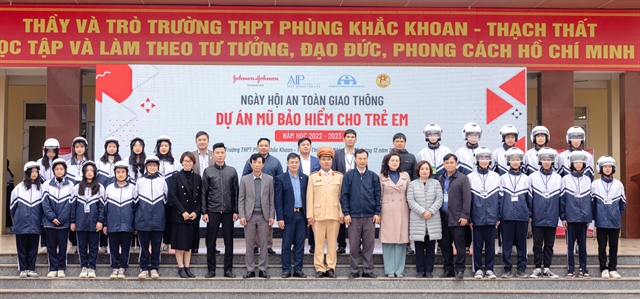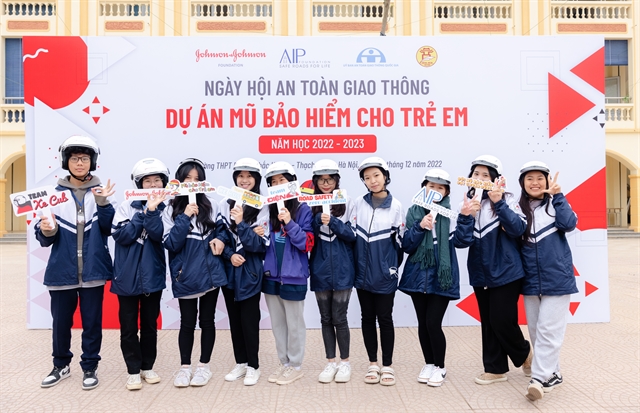Compared to the Vietnamese standard, ECE 22.05 standard helmets can absorb higher values of energy that occur during an impact.

Johnson & Johnson is pioneering helmet safety standards innovation by bringing the first United Nations ECE 22.05 Standard helmets to Viet Nam. The ECE 22.05 helmet is a revolutionary new helmet that champions safety while being affordable and accessible to all.
As part of the growing legacy of the Helmets for Kids programme supported by Johnson & Johnson, AIP Foundation in collaboration with the National Traffic Safety Committee and Ha Noi Department of Education and Training hosted a helmet handover ceremony and a Road Safety Day at Phung Khoac Khoan – Thach That High School.
This year, the helmet handover is notable as the project piloted a new helmet model that meets the United Nations ECE 22.05 Standard. Compared to the Vietnamese standard, ECE 22.05 standard helmets can absorb higher values of energy that occur during an impact.
The ECE 22.05 helmets are designed with geometries and materials with enhanced mechanical properties. The ability of the helmets to absorb more energy leads to a significant reduction of the energy transmitted to head that, if not reduced over certain values, can potentially create injuries to the rider.
Johnson & Johnson is the first AIP Foundation partner to introduce and support this initiative to improve the quality helmet use among students as part of its Helmets for Kids programme. 5,000 helmets of which 2,000 are part of the ECE 22.05 pilot programme, will be distributed to three target schools as part of the helmet handover ceremony and Road Safety Day this year. The helmets for this handover were produced by Protec, AIP Foundation’s social enterprise. The helmets make a life-saving difference for vulnerable students on their way to and from school in Ha Noi. Wearing a quality helmet can reduce the risk of death by 42 per cent and the risk of serious brain injury by 69 per cent.
Phung Khoac Khoan – Thach That High School is located on a provincial road that is often plagued by heavy traffic. The area outside the school exposes high risks for road crashes. The helmet-wearing rate among students is currently particularly low, as only 16 per cent of students wear helmets. Most students commute to and from school by motorbikes and electric bikes daily.
“Community is at the heart of the Helmets for Kids programme, focusing on how we can all make a difference to be safer on the roads. The helmet handover ceremony and the Road Safety Day at Phung Khoac Khoan – Thach That High School will continue to promote community awareness of the life-saving importance of increasing young adult helmet use. It is the biggest event of the Helmets for Kids programme this year,” shares Nguyen Thu Hang from Johnson & Johnson.

The event commenced with a welcome and introduction by Tran Huu Minh, Chief of the National Traffic Safety Committee (NTSC) Office, and Johnson & Johnson, respectively. Following the introduction, the students participated in a helmet fitting and engage in road safety activities and games. This brings about a unique opportunity for every child at the school to learn more about helmet safety through educational activities as well as marking a chance to spread the word about the importance of helmet safety among the local governments and members of the community.
“It is great to see the first initiative of the ECE 22.05 Standard helmets in Ha Noi, Viet Nam. The National Traffic Safety Committee and the Government of Viet Nam remain committed to tackling the use of low-quality helmets in our country. We hope to see this initiative spread all across Viet Nam,” remarked Dr. Tran Huu Minh, Chief of the NTSC Office.
From 2012 to 2022, the Helmets for Kids programme, with the support of Johnson & Johnson, has provided over 74,000 helmets to schools across 9 Vietnamese provinces, in addition to providing tools and resources to ensure children in the community are commuting to school safely. — VNS





